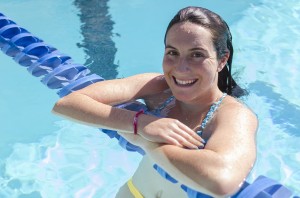Kelly Kosmo just wanted to run.
As a high school sophomore, Kosmo was working toward being recruited for cross-country or swimming until stress fractures took her out of the game. Without any college athletic scholarship offers as she neared high school graduation, it appeared her athletic career was also coming to a close.
Once she reached UCLA, Kosmo switched gears.
“The whole process of not being able to run for an extended period of time was a learning experience,” Kosmo said. “At the time, it was not that great, it was a little bit upsetting. But looking back on it, it was one of the greatest things that happened because it’s what ultimately got me into triathlon.”
Kosmo joined club triathlon the fall of her freshman year. Over the course of the next four years, she saw the team transform from a casual club to a national contender. At the first-ever USA Women’s Collegiate Triathlon National Championship in November, the senior triathlete placed first, leading her team to an overall first place finish.
“When I joined, pretty much everyone on the team at that point was totally new to triathlon or their entire triathlon experience had been at UCLA,” Kosmo said. “Since then, over the last few years, it’s really seemed to grow in popularity as a sport and as something that is being promoted.”
During the club’s transformation, Kosmo said that an increasing number of students joined the team with previous triathlon experience, contributing to the team’s growth.
The team’s growing popularity has to do with the potential of the women’s program to become a Division I sport, she said.
“More women are coming to college, so it’s more likely that schools will be able to add a women’s sport,” said coach Brady O’Bryan. “Plus there’s sports like football and basketball that take up a lot of resources that have to be balanced out.”
Triathlon was named an “emerging sport” by the NCAA in January 2014 – a distinction given to women’s sports that are under consideration to be made official Division I teams.
There is no Division I league for collegiate triathlon, making club the highest level of competition and nationals the sport’s biggest stage. While winning nationals bookended Kosmo’s successful college career, it also spoke to the growth of UCLA’s club triathlon program. The Bruins brought four female athletes to the event, the largest group of any school.
That growth, Kosmo said, can largely be attributed to O’Bryan.

“I think (O’Bryan’s) attitude really helps everyone maintain a positive and relaxed attitude toward the sport,” Kosmo said. “He really encourages you to do the best that you can but will never get upset with you, or criticize or punish the work that you do.”
Liz Noey, a lecturer in the chemistry department, ran Division I cross-country for the University of San Francisco before heading to UCLA for graduate school. After an adviser suggested she look into club triathlon, Noey joined the team. Noey said that she found the dedication of her teammates inspiring seeing as no one was on scholarship.
“It puts all the power in the hands of the athletes, which leads to a more lighthearted environment,” said Noey, who came in eighth at the USA Triathlon Collegiate National Championship this year. “We’re serious racers; the women’s team won the collegiate nationals in 2014 and 2015. So we still brought the intensity to practice … but there was something nice about it being completely your choice when, why and how you were going to work out.”
The positive environment surrounding club triathlon is something that O’Bryan has been cultivating since his undergraduate career as a member of the club. He started coaching club triathlon in September 2011, three months after he graduated from UCLA with a degree in mathematics.
O’Bryan helped form the Collegiate Triathlon Coaches Association, a vital step in receiving recognition as a Division I sport. The coach said that sand volleyball recently underwent a similar transition. UCLA’s sand volleyball team is now in its second official Division I season.
“You think that people have this all mapped out, that there’s a formula to creating a new sport, but there really isn’t,” O’Bryan said. “Every sport is different.”
Aside from its competition level and division distinction, another aspect of triathlon that distinguishes it from many other club teams is its intensity and rigor. The team trains up to six times a week, circulating through running, swimming and biking workouts.
Noey said teammates hold themselves accountable, which has led to the club’s exponential improvement.
“I think there’s something really beautiful about club sports, honestly,” Noey said. “I know we’re moving to be (an) NCAA (sport) and that will bring a lot of good things, but my experience with the club sport has been really amazing because everyone on the team is there because they want to be.”
